![]()
A CTD measures Conductivity, Temperature, and Depth.
D (Depth): Despite having depth in the name, all CTDs actually measure pressure, which is not quite the same thing. The relationship between pressure and depth is a complex one involving water density and compressibility as well as the strength of the local gravity field (a function of the latitude). In oceanography, pressure in a body of water is measured in decibars; the pressure at the surface of the water is 0 decibars. As an approximation, each 1 meter depth of water (3.28 feet) is equivalent to 1 decibar (for example, the pressure is 10 decibars at 10 meters depth).
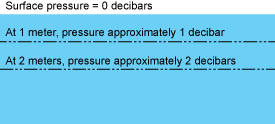
T (Temperature): Temperature is measured in ITS-90 degrees Celsius (°C). ITS-90 is an instrument calibration standard agreed to by a number of scientists in 1990, which provides for comparison and compatibility of temperature measurements internationally (so 25 °C in the U.S. is the same as 25 °C in China, etc.). For the ocean, temperatures typically range from -2 to 35 °C (28.4 to 95.0 °F).
C (Conductivity): Finally, we get to Conductivity, the parameter you may be least familiar with. Conductivity is a measure of a material’s ability to conduct an electrical current. For electrical circuits, metals have high conductivity, while glass has low conductivity. Water with a large amount of dissolved salts has high conductivity, while fresh water has low conductivity. Temperature also affects conductivity: warm water has high conductivity, while cold water has low conductivity. The units for conductivity are Siemens/meter (S/m). For water ranging from freshwater to seawater, conductivity typically ranges from 0 to 7.5 S/m.
Why are we interested in conductivity? If we measure conductivity, temperature, and pressure, we can calculate the amount of dissolved salts in the water – the salinity. The units for salinity are PSU (Practical Salinity Unit); a typical value in the ocean is 35 PSU. Once we know salinity, we can calculate many other parameters, such as density and sound velocity.
The term CTD is often used to describe a package that includes the actual CTD as well as auxiliary sensors to measure other parameters (such as dissolved oxygen, pH, turbidity, fluorometer, altimeter, etc.).
What can we do with data from a CTD?
Types of CTDs
Profiling CTDs
A profiling CTD measures water parameters as it travels through the water, typically lowered over the side of a ship with a winch to take measurements of a vertical column of water. A profiling CTD package often is placed inside a cage, to protect the package from collision with the side of the ship. A profiling CTD package can also include a water sampler that collects samples for later analysis in the lab.
Some more profiling terminology:
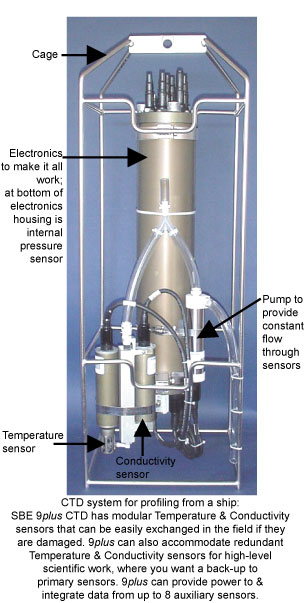 |
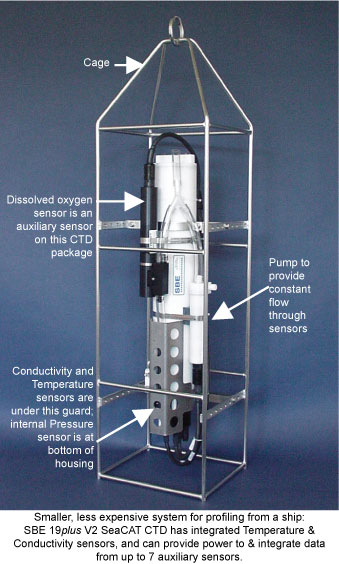 |
Profiling CTDs can also be deployed in many ways other than being lowered and raised from a ship. They can be integrated with an autonomous vehicle like an ROV (Remotely Operated Vehicle), a glider, or an Argo float that drifts with the currents. The type of vehicle and characteristics of its use dictates the CTD design that will provide the best data; CTDs are not one-size-fits-all instruments, if you are interested in good data.
Because some of these CTDs are deployed for an extended period of time (3 to 5 years for an Argo float!), they are subject to fouling – the growth of marine organisms on and inside the sensors. Fouling is more common in warm surface waters. Sea-Bird uses EPA-approved anti-foulant devices to keep the inside of the sensors clean, so that fouling will not affect the measurements.

|
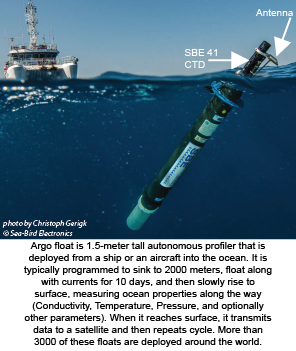 |
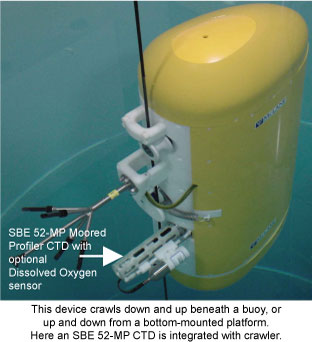 |
Moored CTDs
A moored CTD measures water parameters in one location, over an extended period of time, providing a time series of data that can reveal information about seasonal variations in the water, incursion of pollutants into the area (such as an oil spill!), etc. To reduce costs, the pressure sensor may be optional for a moored CTD, because the deployment depth (and therefore pressure) is approximately known. Similar to profiling CTDs, some moored CTDs can be integrated with sensors for measuring additional parameters (dissolved oxygen, turbidity, fluorometer, etc.).
Because moored CTDs are in place for an extended period of time, they are subject to fouling – the growth of marine organisms on and inside the sensors. Fouling is more common in warm surface waters. Sea-Bird moored CTDs use EPA-approved anti-foulant devices to keep the inside of the sensors clean, so that fouling will not affect the measurements.
 |
 |
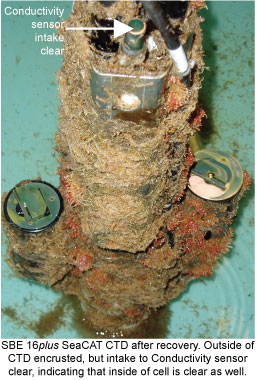 |
Thermosalinographs
A thermosalinograph is basically a shipboard CTD without a pressure sensor. Thermosalinographs are used to collect information about the sea surface, typically in flow-through systems operating continuously throughout a cruise. Thermosalinographs are usually installed inside and near to the hull of a ship in order to make measurements on uncontaminated seawater. Thermosalinograph data can be used to calculate salinity, density, sound velocity, and other parameters of interest. You can often plumb other types of sensors into the system for a variety of other measurements.
Similar to moored CTDs, thermosalinographs are also subject to fouling. And like our moored CTDs, our thermosalinographs use anti-foulant devices to keep the inside of the sensors clean.
Water sampling equipment usually consists of:
The bottle end caps are connected by a tensioning device, either an elastic cord going through the inside of the bottle or a spring on the outside of the bottle. The water sampler is typically deployed with all the bottle end caps held in the open position by the lanyards, allowing water to freely flush through the bottles. When the trigger mechanism fires, the lanyards are released, and the bottle end caps snap closed, trapping a water sample. Each bottle has an air vent near the top, to allow any air trapped in the bottle to escape. Each bottle also has a water valve near the bottom, for easily removing the water sample when back on deck.
Water samplers are built in many sizes, and the bottles are also available in many sizes. Sea-Bird builds water samplers that can hold bottles as small as 1.7 liters each, up to as large as 30 liters each (0.4 to 7.9 gallons). These samplers can hold as few as 3 bottles, and as many as 36 bottles.
More water sampling terminology:
 |
|
|
|
|
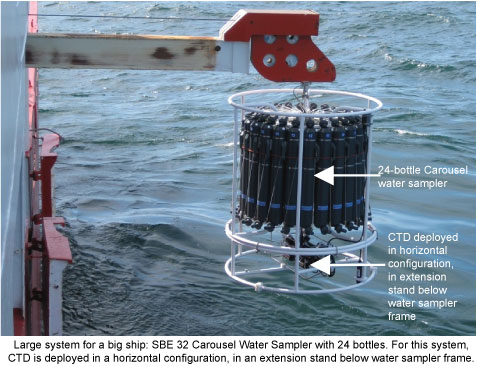 |
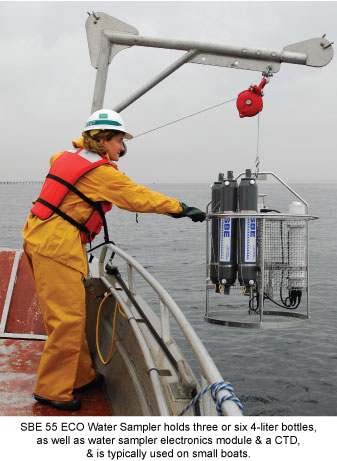 |
| Date | Description |
| July 2012 | Initial release. |
| December 2013 | Replace old Argo photo with one from Navis. |
![]()
Sea-Bird Home Phone: (+1) 425-643-9866 E-mail: seabird@seabird.com